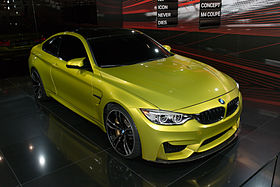(All wallpapers are HD)
The BMW M4 is a high-performance version of the 4 Series automobile developed by BMW's in-house motorsport division, the BMW M GmbH, the M4 is one of the Fastest M cars ever produced by BMW achieving 0-100km/h (0-62m/h) in just 4 seconds. Part of the renumbering that BMW splits the 3 Series coupe and convertible models to the 4 Series (to further differentiate with the 3 Series sedans), the M4 replaces the M3 Coupe and Convertible models, as well as the Gran Coupe. Upgrades over the standard 4-Series include: a very powerful and responsive, twin turbocharged engine; improved handling, suspension, and braking systems; aerodynamic body enhancements; interior/exterior accents with the tri-colour "M" (Motorsport) badging; the significantly reduced weight compared to the standard 4 series and its predecessor with an all-new stiffer chassis and extensive use of carbon fiber, especially the roof of the car.
It has a bitter rivalry with the bonkers Mercedes C63 AMG and Audi's RS5, not to mention cars like the Maseratti Ghibli, Alfa Romeo Giulia and Lexus RC-F.
F82 M4
BMW officially presented the M4 concept on August 16, 2013. However, the concept car did not reveal any interior or technical details. On September 25 2013, BMW released technical specifications of the M4 which will be powered by M-tuned S55B30 engine, although it is a 3.0 L inline engine BMW says it is completely different to the N55 engine seen in other BMW 35i models, this engine has been built specifically for the New M4/M3, displacing 3.0 L (180 cu in) and redlining at 7,500 rpm. The rev limiter coming in at 7,600rpm. The engine will use two mono-scroll turbochargers with boost peaking at 18.1 PSI.
The power is rated at 425 hp (317 kW; 431 PS) while torque will be 550 N·m (410 lb·ft). The weight of the 6 speed manual M4 will be 3,556 lb (1,613 kg), with the M-DCT some 40kg heavier. Both 6-speed manual and 7-speed M-DCT transmissions will be available. The 7-speed M-DCT transmission will accelerate the car from 0-60 mph (97 km/h) in 3.9 seconds. The 6-speed manual transmission will do 0-60 mph (97 km/h) in 4.1 seconds.
Carbon fiber reinforced plastic will be used extensively throughout the car, including drive shaft, roof, roof bow, trunk, and front strut brace. For the first time in the M vehicle, an electric power steering unit will be used. The steering system will be specifically tuned for the M3 and M4. The 18 inches (460 mm) and 19 inches (480 mm) wheel options will be available with lightweight forged alloys being standard. The M compound brakes will be standard (in blue), while carbon ceramic brakes (in gold) will be available as an option.
The M4 will feature Active Sound ,A live amplification of the engine's natural sound will be inducted into the passenger cabin via the speakers, BMW says this technology is been used because of the well insulated cabin to avoid road / wind noise but still provide the driver the sporty sound of the M powered Engine . There will not be any artificial sound or any pre-recorded track. Overall, 70 percent of the components on the M4 will be standalone compared to the F32 4 Series.
F83 M4
The convertible weighs 1,839 kilograms (4,055 lb), 41 kilograms (90 lb) less than its predecessor. The three-piece retractable hardtop folds in 20 seconds.
Motorsport
Four teams used M4s in the 2014 Deutsche Tourenwagen Masters season, with Marco Wittmann and Maxime Martin winning five races between them.



























